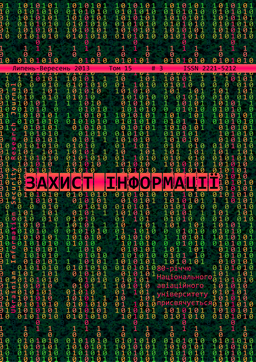Technology of determining the rational structure of the information and telecommunication system of the state border guard service of ukraine on the basis of reserve channels
DOI:
https://doi.org/10.18372/2410-7840.15.4861Keywords:
Efficiency, information and telecommunication system, the State Border Guard Service of Ukraine, technology efficiency, redundancy channelsAbstract
The effectiveness of the border protection depends on die efficiency of die telecommunications system of die State Border Guard Service of Ukraine. The availability of its individual segments do not meet international requirements for telecommunication systems. Existing methods of increasing of die efficiency of telecommunication systems do not include features of telecommunication system of die State Border Guard Service of Ukraine, namely the impact of its functioning on the effectiveness of die border. The article presents die technology for determining the rational structure of die information and telecommunication system of die State Border Guard Service of Ukraine on the basis of reserve channels taking into consideration die indicator of the operational and service activiti of the border guard units. This technology allows to make the rational choice of building a network component of information and telecommunication system of the State Border Guard Service of Ukraine with die reservation of channels and using the dynamic routing protocol.
References
Басараб, О. К. Методика визначення комплексного імовірнісного показника ефективності оперативно-службової діяльності на основі моделювання функціонування мережі / О. К. Басараб // Вестник Инженерной академии Украины. — 2013.-№ 2. - С. 23-26.
Басараб, О. К. Формування комплексного ймовірнісного показника ефективності оперативно-службових дій Державної прикордонної служби України в залежності від функціонування телекомунікаційних систем / О. К. Басараб // АСУ та прилади автоматики. — 2013. — № 2. — С. 38-40.
Катеринчук І. С, Періг В. М, Концептуальні засади експертизи телекомунікаційних систем. Збірник наукових праць Військового інституту Київського національного університету імені Тараса Шевченка №28 / головний редактор Лєнков С. В.-Київ : Видавництво ВІКНУ, 2010. - С. 76-78.
Методика експертизи телекомунікаційних систем в умовах невизначеності. Звіт про НДР / НАДПСУ. Шифр 210-0018 А - Хмельницький, 2010.-74 с.
Періг В.М. Експертиза телекомунікаційних си¬стем в умовах невизначеності з використанням методів штучного інтелекту. Матеріали VII Міжнародної науково-практичної конференції «Військова освіта та наука: сьогодення та майбутнє», 24-25 листопада 2011 р. Військовий інститут Київського національного університету імені Тараса Шевченка. — Київ : Видавництво ВІКНУ, 2011. -С. 66-67.
Частиков А.П, Гаврилова Т.А, Белов ДА. Разработка экспертных систем, среда CLIPS. — С- Пб.: БХВ-Петербург, 2003. - 608 с.
Basarab, О. К. (2013) "Method for determination of the complex probabilistic indicator of the operation-al and service activiti by modeling the network.", Bulletin of Engineering Academy of Ukraine, No. 2, pp. 23-26.
Basarab, О. K. (2013) "Formation of the complex probabilistic indicator of the operational and service activiti of the State Border Guard Service of Ukraine depending on the operation of telecommunications systems", Automated Control Systems and Devices, No. 2, pp. 38-40.
Katennchuk, I. S, Penh, V. M. (2010) "Conceptual Foundations of expertise telecommunication systems", The Military Institute Collection of Scientific Papers, No. 28, pp. 76-78.
National Academy of the State Border Guard Service of Ukraine. (2010) "Method of examination telecommunication systems under uncertainty", Khmelnitsku: NASBGSU (210-0018A).
Perih, V. M. (2011) "Examination of telecommunication systems under uncertainty using artificial intelligence techniques", Materials of VII International Scientific Conference "Military Education: Present and Future", pp. 66-67.
Chastikov, A. P, Gavrilova, T. A, Belov, D. L. (2003) "Development of expert systems. Programming environment CLIPS", S-Pb: BHV- Peterburg.
Downloads
Issue
Section
License
Authors who publish with this journal agree to the following terms:- Authors retain copyright and grant the journal right of first publication with the work simultaneously licensed under a Creative Commons Attribution License that allows others to share the work with an acknowledgement of the work's authorship and initial publication in this journal.
- Authors are able to enter into separate, additional contractual arrangements for the non-exclusive distribution of the journal's published version of the work (e.g., post it to an institutional repository or publish it in a book), with an acknowledgement of its initial publication in this journal.
- Authors are permitted and encouraged to post their work online (e.g., in institutional repositories or on their website) prior to and during the submission process, as it can lead to productive exchanges, as well as earlier and greater citation of published work (See The Effect of Open Access).

